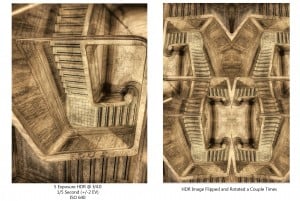I have been avidly working on the images from my last trip to Kansas City and the Nelson Atkins Museum. I took a crazy looking shot of the upstairs view looking down on the granite staircase. It turned out to be a very great HDR image, but I felt I could take it to the next level a bit. So I flipped it and rotated it a couple of times and thought I had something even better. However, a little birdy told me to continue playing with it so I did. I am happy with the outcome and have actually started doing more of these and will more than likely continue.
I don’t really know what to call them yet, I mean isn’t that what you are supposed to do, name the new thing you are doing with a photograph? Rotatographs, Flippozonatlverticograph, or I guess I could run them through Pixel Bender and call it a Paintograph or take an iPhone pic of it and call it an iPhonograph, isn’t that the new trend?
Tip For The Week:
If you ever flip or rotate an image around itself it is always helpful to reduce the symmetry where the copies meet. Use cut and paste, clone stamp, healing brush, or even the spot healing brush to cover up any obvious symmetry. This will have a significant impact on the way the viewer interprets the image. If there is too much symmetry the piece is easy to navigate. Try a gentle balance of asymmetry and symmetry, this will fool the viewer for a few extra seconds.










